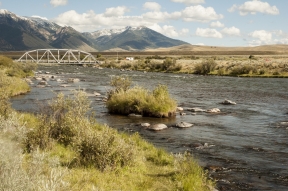
A few weeks ago as I was driving back from Bozeman I slowed on a bluff overlooking the Madison River. My mind wandered back to 1979, a time long ago when guide A J Campbell and I landed our boats at an unimproved access at least two miles downstream from what is now the Story Ditch Access. We had floated from Ruby Creek Campground with some customers from Palo Alto, California. The sun was starting to set across the river by the time we got our boats loaded. The tranquility of the sunset brought forth a peaceful easy feeling for all of us. Everyone had caught some nice trout and we had seen few other anglers on the water.
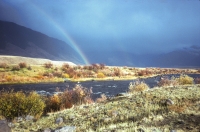
I took the last guide trip I will ever take on the Madison in this same section a couple of years ago. Since then I have let my license lapse. I was fishing with Rear Admiral Jim Greene, a past board chair of the Henry’s Fork Foundation. We had chosen to take on the Madison during the busy salmon fly hatch, something I rarely do. One reason I have always liked the float from Ruby Creek to Story is because there usually isn’t as much boat traffic during the morning hours even during busy salmon fly time. Most of the boats come from Palisades where they float to Ruby Creek, MacAtee or on down to Story.
I like the first mile below Ruby Creek where you can spend several hours working the many runs, pockets, banks and riffles. Jim was out of the boat hooked up to a nice brown when I looked upstream and saw one of the first boats coming down from above. We were stationed about 30 feet from the far bank where there were several nice fish slashing the big flies. As the boat got closer I could see that he had a direct bead on us and I positioned myself next to Jim to help prevent him from being run over. Thankfully the boat didn’t crash into us but instead floated between us and the bank directly over the trout that were feeding. I started to chalk it up as an inexperienced boater who didn’t know better until I spotted the red and white boat sticker that marked the man at the oars as a guide. This sticker not only identifies the boat as a Montana guide but also provides the guide’s license number. In his case the number was sixteen thousand something. While not always the case, the license number is a good indicator of the guide’s experience. For example the license I recently gave up was #292.
I had never been to the modern improved Story access. I expected to float another two miles so I was surprised when I saw the boat ramp coming up on the right. It cut our day a little shorter than I had planned but we had had a great day none the less. I was treated to another surprise when I walked from the ramp up to the parking area which was full of vehicles and trailers.
As we drove back up river along the river I was amazed at the number of boats drifting down the river and being towed behind vehicles on the highway. My mind drifted back to what is was like in 1974 when I took my very first guide trip working for Jim Danskin in West Yellowstone.
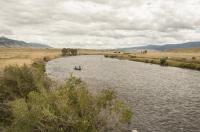
Today the Madison River has more fishing pressure than any other river in Montana. A group has been organized called the Madison River Negotiated Rule Making Committee to consider adopting measures to ease the social conflicts on this popular fishery. The group has had their first meetings earlier this month and will continue to hold additional meetings with the hope that they can find consensus with the crowds on the Madison. It is not my purpose to regurgitate news about all of this. There is a great article you can read that gives the gist of this effort.
I’m not sure whether Montana’s Fish, Wildlife and Parks is trying to respond to the public outcry about crowding on the Madison or the agency has determined to take it upon itself to decide who can fish the Madison River and who can’t. One thing for certain, the fishery is in good shape and the heavy fishing pressure has not had a negative impact according to fisheries managers.
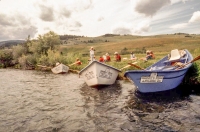
This isn’t my first rodeo on the subject of crowds. Back in the late 70s and early 80s the Harriman Ranch section of the Henry’s Fork had more anglers than it does now. Like now, most anglers wanted regulation and restrictions. Like now they wanted the guides kicked off the river. Like now, they wanted regulations but they wanted everyone else restricted except themselves.
Way back in the early 1980s I was invited to join an advisory group in an effort to consider restrictions on outfitters on the Madison River. I was in good company with several of my mentors including Pat Barnes, Bud Lilly, Bob Jacklin and Jim Danskin. For starters the idea was put in place a moratorium on all new outfitters and guides. I’m not sure why but it never got past our initial meetings..
When I started my own business in 1976 Idaho had already restricted the number of outfitter licenses on all rivers across the state. In order for us to get in the game we had to buy somebody else out. There were a total of 7 outfitter licenses on the Henry’s Fork. More than 50 years later that number has not changed. Later outfitters met together with state agencies to reach an agreement to restrict the number of guides each outfitter can employ on any given section of a river at any one time. Idaho’s system is similar to a state liquor license with “haves” and “have nots.” I’m one of the haves so I like it. One thing that I remember my dad taught me when I was growing up is that “life ain’t fair.” Idaho’s system may not be fair but it works. In the case of Montana the toothpaste was squeezed out of the tube quite some time ago. Every river is fair game for all outfitters and guides across the state. Now they’re trying to put all of the toothpaste back in. Good luck.
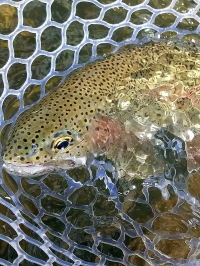
Last week I shared a video on this subject on Facebook. As expected there were a lot of comments and also, as expected, the majority of the comments were directed towards guides. For that reason I’ll focus the remainder of my comments on this subject. It’s a subject I know something about. There is a great difference between how guides and outfitters are defined in Idaho and Montana. It’s complicated and I’m not going to talk about how to make the sausage in this blog but I’ll address it at a later time.
If the fishing public feels the best way to regulate the Madison River is to ask the government to restrict themselves it is important to stay focused. For example, one of the responses to the video came from another guide. His solution was for the Idaho guides to stay in Idaho and not crowd his rivers in Montana. I looked him up on the Montana Board of Outfitters website. He has been a guide for 8 years. His guide license number is 10,XXX. He apparently believes that kicking out non-resident guides who have been guiding on the Madison since before he was born will solve the problem.
That same idea was floated in our meetings almost 40 years ago. Here’s why that is not a solution to the problem. Montana would have to pass a law making it illegal to issue guide licenses to out-of-state guides. If that happened Idaho would reciprocate. Right now there are only a couple of the Idaho outfitters operating on the Madison River. At the same time of the 7 outfitters legally licensed to operate on the Henry’s Fork two are from Montana. Since they wouldn’t be able to take their clients to Idaho anymore they would take them somewhere else, likely the Madison River. Would kicking Idaho guides off the Madison help resolve the issue?
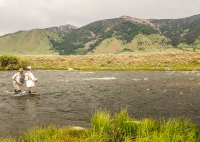
With the Madison River all outfitters are required to report all trips to two different state agencies with the number of clients, client information, rivers and river sections. Reports to these agencies are very specific. From there agencies can easily determine the number of guided anglers using any section of the Madison River. According to this data in 2017 of 207,000 user days on the upper Madison only 19,662 were anglers fishing with guides. That’s only about 10%. How can that be you say? Is it possible guides are not properly reporting their trips? Personally I doubt it because these rules are strictly enforced. There is an enforcement officer checking all of the guides on a daily basis. A guide who was checked on a specific trip that wasn’t reported can result in a severe penalty or loss of the special river permit.
It is important to realize that not all drift boats and rafts are guides. Drive around the streets of Bozeman or West Yellowstone and you’ll likely see boats parked on almost every block. The four biggest drift boat manufacturers in the world are located within a 100 mile radius of the Madison River. When I started guiding almost every drift boat or raft was a guide. It would be interesting to know how many private individuals own drift boats or rafts today compared to 40 years ago. If there are two anglers fishing a stretch of river from a drift boat, they will be visualized by every angler on the section being floated. If the same two anglers are wading somewhere within the same section they will only be noticed by a few anglers who are fishing near them.
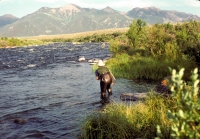
If we demand the agencies restrict the public the question is, who is the public? There is a perception among many that there is the public and there are guides. Guides do not fish. Their customers do the fishing. It is easy to place restrictions on the guided public. It is not so easy to restrict the non-guided public. Many anglers of the non-guided public can easily spend $7000 or more for a drift boat and related equipment. Customers of guides prefer to use their dollars differently. Is it right to discriminate against this portion of the fishing public simply on the basis that they choose to fish with a guide?
Restricting the public using their own resource based strictly on social issues is treading on very dangerous ground. There is no way to resolve this without contention and conflict. The first question that should be asked is how many are too many? Who should be restricted? As I said before most people clamoring for restrictions want everyone else restricted except themselves.
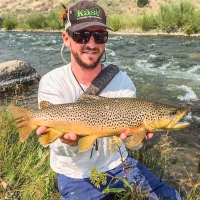
The Madison River is not the only place where the biggest issue seems to be how to manage people rather than fish. I’ve seen it here on the Henry’s Fork, the South Fork of the Snake and more recently the upper Teton River. A number of years ago I served on a panel with Jack Dennis and John Gierach at the University of Wyoming in Laramie. At that time there was a big uproar over crowds on the North Platt River. One old college professor pointed out that he had been fishing the river for 30 years and the crowds had become intolerable. He demanded the fish and game department do something about the crowds. He wanted each of us on the panel to respond
John Gierach said that when he first moved to Boulder his favorite place to fish was Cheeseman Canyon on the South Platt. It eventually became very crowded and the trout became so selective that they wouldn’t eat a size 14 Adams anymore. He said he quit going there in favor of going somewhere else that wasn’t as crowded where the trout would eat a size 14 Adams. Easy solution.
I decided to pull the professor’s leg with my response. I wanted to point out that any restriction on the public would result in anger and frustration. I suggested that all anglers who had fished the North Platt more than 20 years should be restricted in order to allow anglers who hadn’t fished the river very long a fair shake. I’m sure you know how that went over. The younger people in the audience clapped.
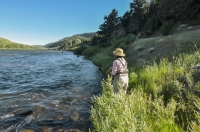
I’m sure that there isn’t one of us who wouldn’t like to go back to the Madison like it was when A J Campbell and I watched the sun set over the big empty river back in 1979. It isn’t going to happen. These misguided attempts to allow the government agencies to try to resolve social conflict will only result in more social conflict.
I still fish the Madison River during the salmon fly hatch. I usually wait until late in the afternoon and wade a couple of favorite stretches. The biggest fish are normally holding in spots that everyone else walks over. Otherwise I fish the river at times of the year that aren’t as popular and crowded. It’s the same on other favorite waters. For example I don’t fish the Harriman section of the Henry’s Fork when it is crowded during Green Drake time. Like John Gierach, I go somewhere else.
All of our great trout rivers are crowded. I’ve been around the block long enough to witness great threats to these resources that will take these fisheries down. All of us, together, with a united front can really make a difference. We must make more of an effort to follow basic rules of behavior. The best solution is to learn to get along with each other.